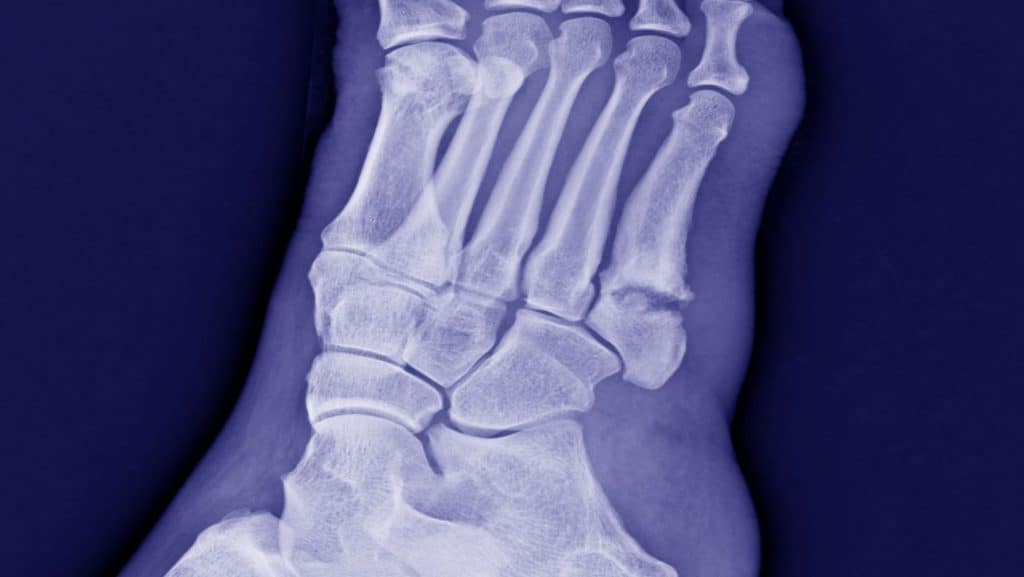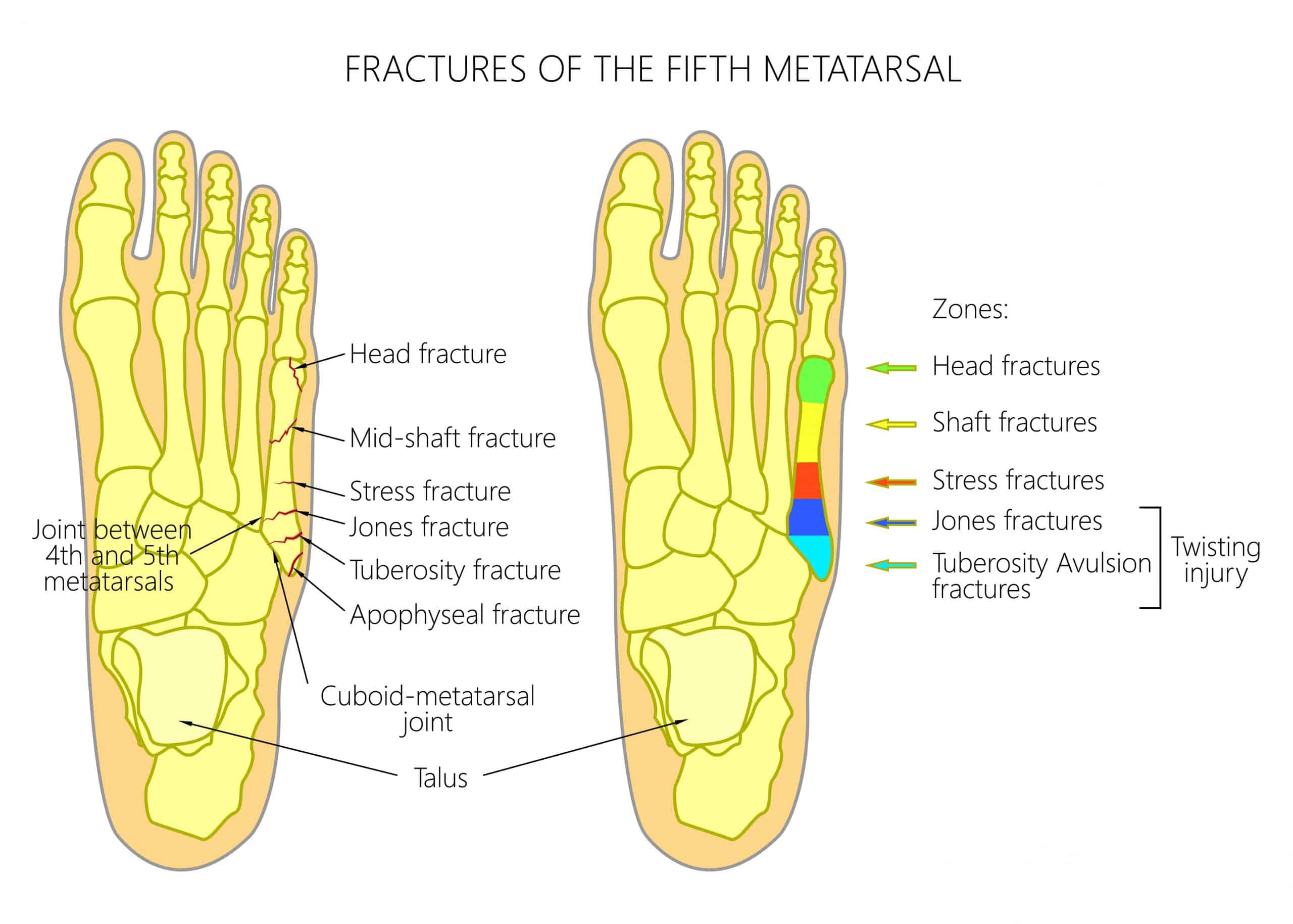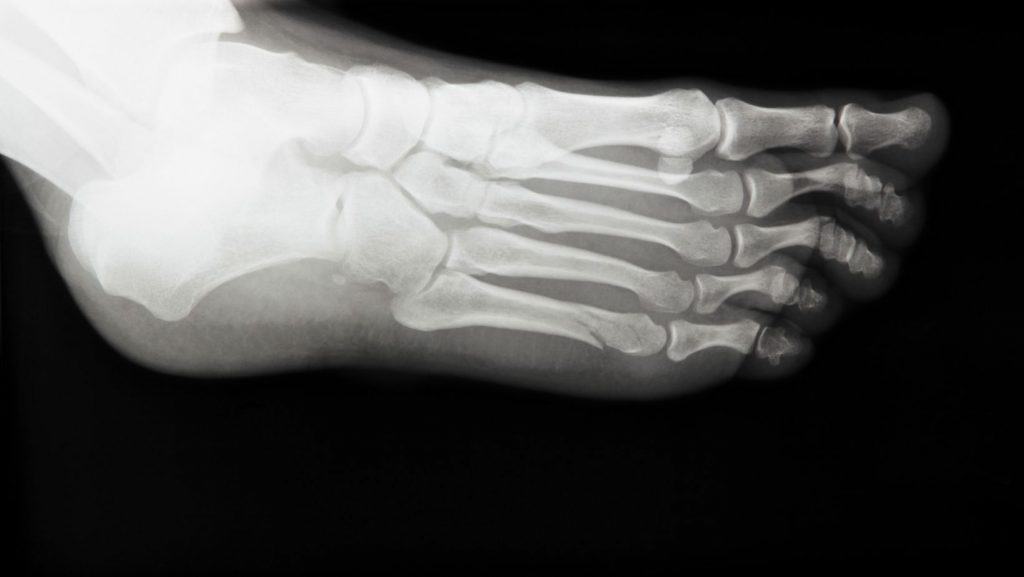Peroneal Tendon Tear
Read More >
5th Metatarsal fracture is a very common cause of foot pain. Located along the forefoot, there are 5 metatarsals in a foot. The 5th metatarsal is the smallest of these and sits on the outer side of the forefoot. It is a long, narrow bone between the tarsal bones of the midfoot and the toes.
One of the 5th metatarsals’ main attachments is the Peroneal muscles, and it is common site of fracture in the foot. There are two main types of 5th metatarsal fracture in an injured foot: 5th metatarsal avulsion fracture and Jones fracture.

The Peroneal muscles attach to the outer edge of the 5th metatarsal bone. On some occasions, these tendons or surrounding ligaments can be injured, and rather than tear in the middle of the tissue they can tear off the bone.
This action pulls small fragments off the bone, and when this occurs in the 5th metatarsal, it is called a 5th Metatarsal Avulsion fracture.
A Jones fracture is a small fracture on the 5th metatarsal in an area of limited blood supply. This type of fracture occurs in the little toe, closer to the ankle bone. As a result of poor blood supply, it is slow to heal. In the general public, a Jones fracture is placed in a walker boot.
This type of fracture would be considered for surgery in the athletic population. It can take up to 3 months for a Jones fracture to heel non-operatively, while surgery can reduce this time to 8 weeks.
This is a fracture in the mid-shaft of the 5th Metatarsal. It is commonly caused by rotation or twisting motion and therefore it is frequently seen in dancers.
This action can also cause a stress fracture or a greenstick fracture of the 5th metatarsal. This is typically managed in a walker boot for 4-6 weeks followed by physical therapy for 3-6 weeks.
This can occur anywhere along the 5th metatarsal. It typically involves a medial or lateral displacement.
Depending on the location or size of displacement these types of fractures can be managed non-operatively or in some instances, surgery is required.

The symptoms of a 5th Metatarsal fracture are variable with some people reporting no pain, bruising, or swelling while others are unable to walk.
When there is pain present, it is usually along the 5th metatarsal, with pain on palpation of the bone. It is usually painful to hop on the affected foot and immediately on weight-bearing with pain ease in a non-weight-bearing position.
If you suspect that you have a 5th Metatarsal Fracture we recommend seeing a Physical Therapist who will be able to carry out a clinical examination to determine if you have a suspected fracture or if you symptoms are the result of another condition such as Peroneal Tendonitis.
X-rays for a stress fracture have been found to be initially negative in up to 82% of cases, illustrating how poor it is as a diagnostic tool for 5th Metatarsal Fracture.
An MRI or CT Scan is the most accurate form of imaging for a 5th Metatarsal Fracture.

Nearly all forms of 5th Metatarsal Fracture are managed conservatively in the first instance. They are normally placed in a walker boot for 4-6 weeks or sometimes longer if the individual has low Vitamin D levels, Osteopenia or Osteoporosis. It is very uncommon to be placed in a cast.
While in a walker boot, Physical Therapy can commence. This usually involves massage on the calf muscle to reduce tightness from being immobalized in the boot. It is possible to do self massage using a foam roller but we would recommend avoiding a massage gun.
Any form of taping such as KT Taping or strapping is not beneficial in the rehabilitation process. We have created a Physical Therapy rehabilitation protocol below:
Maintain soft tissue mobility of the calf and surrounding muscles from massage therapy. You should wear a walker boot all of the time.
Introduce some light theraband strengthening exercises for the Calf, Peroneal and Posterior Tibial Muscles in a non-weight-bearing position. Continue with massage therapy.
Begin to wean out of the boot indoors, progressing outdoors as pain allows in cushioned shoes. Progresses to weight-bearing strength exercises, including balance and stability exercises in standing. Ensure full ankle mobility with Gastrocnemius and Soleus Stretches.
Introduce hopping and plyometric exercises. Carry out sport-specific rehabilitation.
You can usually return to running during this period if it is pain-free.
The following factors should be considered to all a 5th metatarsal fracture heal as quickly as possible:
This article is written by James McCormack, a Lower Limb Specialist who is an expert in treating Metatarsal Fractures.
This is not medical advice. We recommend a consultation with a medical professional such as James McCormack if you are experiencing any of the symptoms discussed in this article. James offers Online Physiotherapy Appointments weekly and face-to-face appointments in his London clinic.